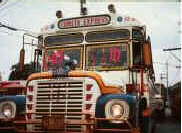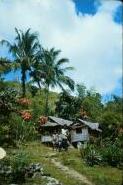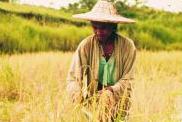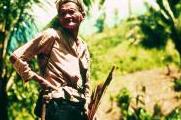Philippines 1976-1977, 1991
 After
graduating from UCLA with a BA in linguistics, I spent 10 months
in the Philippines doing language surveys with the Summer Institute of Linguistics. My
first stop was Manila, a busy metropolitan area with about 9
million inhabitants. There are about 30 distinct languages spoken
in the Philippines, all of which are of the Western Austronesian
branch of the Austronesian languages. Before Western colonial
expansion, Austronesian was the geographically most widespread
language family in the world, extending from Easter Island off
the West coast of South America, to Madagascar, off the East
coast of Africa, and from New Zealand in the South to Hawaii in
the North.
After
graduating from UCLA with a BA in linguistics, I spent 10 months
in the Philippines doing language surveys with the Summer Institute of Linguistics. My
first stop was Manila, a busy metropolitan area with about 9
million inhabitants. There are about 30 distinct languages spoken
in the Philippines, all of which are of the Western Austronesian
branch of the Austronesian languages. Before Western colonial
expansion, Austronesian was the geographically most widespread
language family in the world, extending from Easter Island off
the West coast of South America, to Madagascar, off the East
coast of Africa, and from New Zealand in the South to Hawaii in
the North.

 The
Philippines is an amazing country composed of over 7,000 islands,
with beautiful beaches as well as rugged mountains and tropical
rainforests. I had the privilege of visiting many different
communities in the Philippines, from Zamboanga City in the South
to Apari on the Northern coast of the island of Luzon. The
picture on the left is of a mountain home in Bikol provice and
the one on the right is a beach on the Island of Caluya in the
Western Visayas.
The
Philippines is an amazing country composed of over 7,000 islands,
with beautiful beaches as well as rugged mountains and tropical
rainforests. I had the privilege of visiting many different
communities in the Philippines, from Zamboanga City in the South
to Apari on the Northern coast of the island of Luzon. The
picture on the left is of a mountain home in Bikol provice and
the one on the right is a beach on the Island of Caluya in the
Western Visayas.
 The
most amazing part of the Philippines, however, is the people. In
true Asian fashion, family and hospitality are very important
values in the many Filipino cultures. Though Filipinos have
struggled under various dictators and occupation forces in the
last century, there is still a deep joy and hope that is evident
everywhere. The Philippines is one of the few countries of the
world in which ordinary people, using non-violent methods, were
able to overthrow an entrenched and militant dictator. This was
the famous "People-power" revolution of 1986 that set
an example for non-violent revolution in Latin America and
The
most amazing part of the Philippines, however, is the people. In
true Asian fashion, family and hospitality are very important
values in the many Filipino cultures. Though Filipinos have
struggled under various dictators and occupation forces in the
last century, there is still a deep joy and hope that is evident
everywhere. The Philippines is one of the few countries of the
world in which ordinary people, using non-violent methods, were
able to overthrow an entrenched and militant dictator. This was
the famous "People-power" revolution of 1986 that set
an example for non-violent revolution in Latin America and  Eastern
Europe in the early 90s. These are a few photos from my travels
around the Philippines.
Eastern
Europe in the early 90s. These are a few photos from my travels
around the Philippines.


 After
graduating from UCLA with a BA in linguistics, I spent 10 months
in the Philippines doing language surveys with the Summer Institute of Linguistics. My
first stop was Manila, a busy metropolitan area with about 9
million inhabitants. There are about 30 distinct languages spoken
in the Philippines, all of which are of the Western Austronesian
branch of the Austronesian languages. Before Western colonial
expansion, Austronesian was the geographically most widespread
language family in the world, extending from Easter Island off
the West coast of South America, to Madagascar, off the East
coast of Africa, and from New Zealand in the South to Hawaii in
the North.
After
graduating from UCLA with a BA in linguistics, I spent 10 months
in the Philippines doing language surveys with the Summer Institute of Linguistics. My
first stop was Manila, a busy metropolitan area with about 9
million inhabitants. There are about 30 distinct languages spoken
in the Philippines, all of which are of the Western Austronesian
branch of the Austronesian languages. Before Western colonial
expansion, Austronesian was the geographically most widespread
language family in the world, extending from Easter Island off
the West coast of South America, to Madagascar, off the East
coast of Africa, and from New Zealand in the South to Hawaii in
the North. 
 The
Philippines is an amazing country composed of over 7,000 islands,
with beautiful beaches as well as rugged mountains and tropical
rainforests. I had the privilege of visiting many different
communities in the Philippines, from Zamboanga City in the South
to Apari on the Northern coast of the island of Luzon. The
picture on the left is of a mountain home in Bikol provice and
the one on the right is a beach on the Island of Caluya in the
Western Visayas.
The
Philippines is an amazing country composed of over 7,000 islands,
with beautiful beaches as well as rugged mountains and tropical
rainforests. I had the privilege of visiting many different
communities in the Philippines, from Zamboanga City in the South
to Apari on the Northern coast of the island of Luzon. The
picture on the left is of a mountain home in Bikol provice and
the one on the right is a beach on the Island of Caluya in the
Western Visayas. The
most amazing part of the Philippines, however, is the people. In
true Asian fashion, family and hospitality are very important
values in the many Filipino cultures. Though Filipinos have
struggled under various dictators and occupation forces in the
last century, there is still a deep joy and hope that is evident
everywhere. The Philippines is one of the few countries of the
world in which ordinary people, using non-violent methods, were
able to overthrow an entrenched and militant dictator. This was
the famous "People-power" revolution of 1986 that set
an example for non-violent revolution in Latin America and
The
most amazing part of the Philippines, however, is the people. In
true Asian fashion, family and hospitality are very important
values in the many Filipino cultures. Though Filipinos have
struggled under various dictators and occupation forces in the
last century, there is still a deep joy and hope that is evident
everywhere. The Philippines is one of the few countries of the
world in which ordinary people, using non-violent methods, were
able to overthrow an entrenched and militant dictator. This was
the famous "People-power" revolution of 1986 that set
an example for non-violent revolution in Latin America and  Eastern
Europe in the early 90s. These are a few photos from my travels
around the Philippines.
Eastern
Europe in the early 90s. These are a few photos from my travels
around the Philippines.
